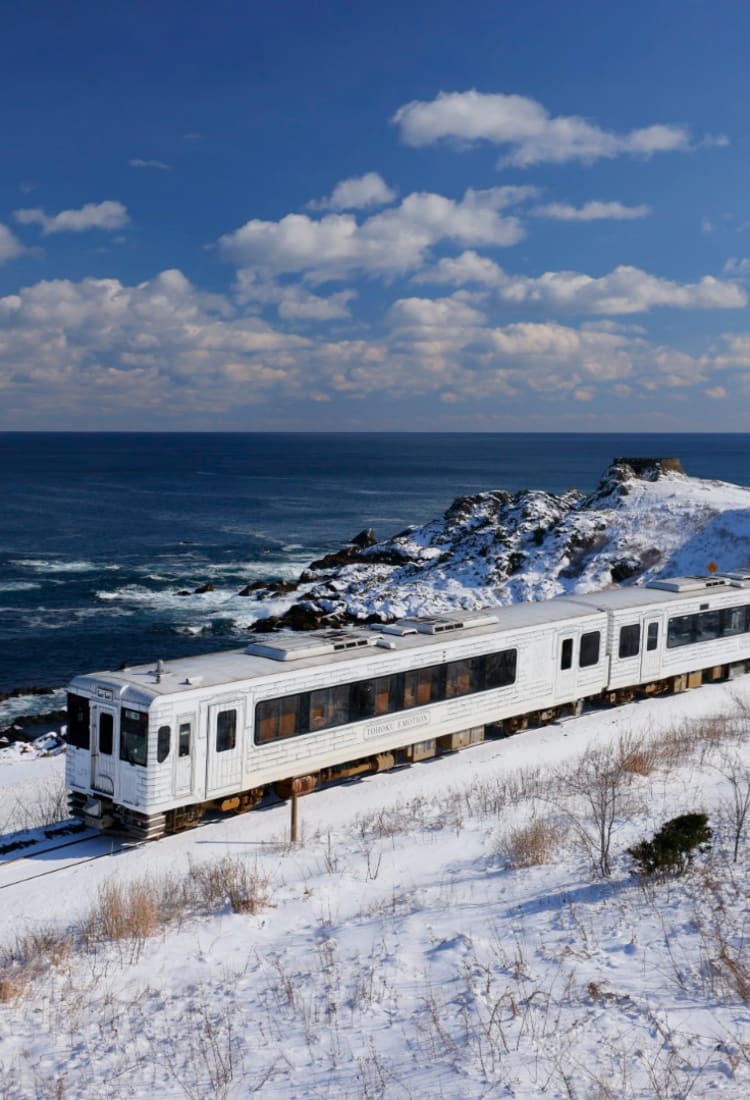
2021.01 Experience the Culture, Beauty and the Flavors of Northern Japan, on a Leisurely Rail Journey
Visitors to Tohoku can experience the area’s food, culture and spectacular vistas on local and scenic trains. Gaze out of a carriage window at the winter wonderland of powder snow and taste local dishes from the comfort of the dining car. Visitors can choose from several distinctive sightseeing trains, including the elegant Tohoku Emotion and the cozy Kotatsu Train.
Tohoku Emotion: Experience design, cuisine and art on a memorable train journey
This Tohoku journey starts at Hachinohe Station in Aomori, less than three hours from Tokyo on the Tohoku Shinkansen (bullet train). Aomori is the northernmost of the six prefectures in Tohoku, and is popular for its natural beauty, including Japan’s first World Heritage Site, the virgin beech forests of Shirakami-Sanchi, and Lake Towada. Many visitors come in summer to see the Aomori Nebuta Festival. At Hachinohe Station, visitors can see a dramatic figure from one of the large floats that is paraded through the city during the annual Hachinohe Sansha Taisai Festival. This summer festival is designated a UNESCO Intangible Cultural Heritage.
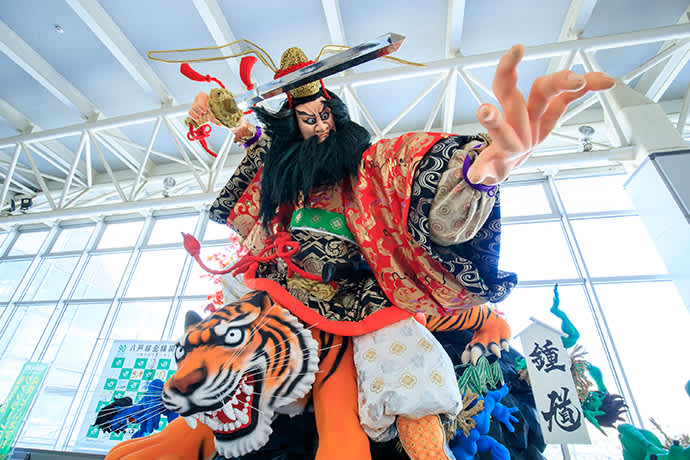
A dynamic figure from a Hachinohe Sansha Taisai festival float is on display at Hachinohe Station.
The journey starts with Tohoku Emotion, a train based on the concept of a “traveling restaurant” to showcase the delights of Tohoku through design, cuisine and art. JR East began operating the train in 2013 to promote the restoration of the Hachinohe Line which had been badly damaged in the Great East Japan Earthquake two years earlier.
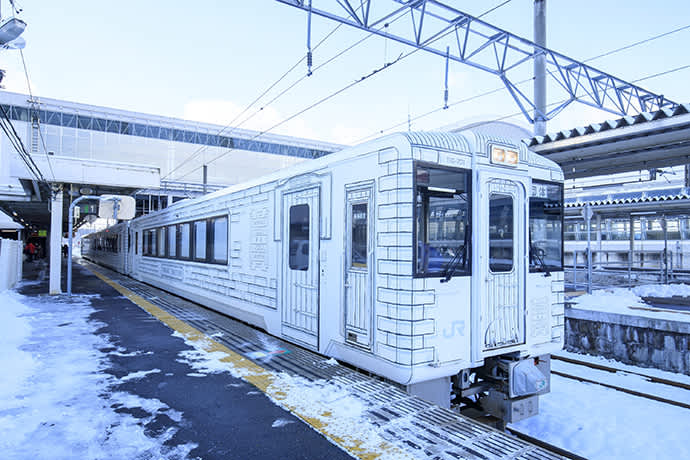
The stylish train was designed by industrial designer Ken Okuyama of Ken Okuyama Design, who has experience designing for Porsche and Ferrari.
The train arrives at Hachinohe Station just before 11 a.m. for the approximately two-hour journey south to Kuji Station in Iwate Prefecture. Passengers walk a red carpet to board the train, adding to the sense of anticipation. The three-car train consists of a dining car with a restaurant-style dining space, a car with private compartments and a car with an open kitchen. The train’s refined interior incorporates traditional Tohoku crafts. The floor pattern of the dining area is derived from Kogin-zashi, a traditional textile from southern Aomori Prefecture. The lightshades in the dining car are made of amber from Iwate, the largest amber-producing area in Japan.

Currently, seats in the open dining car are divided by acrylic partitions, and staff wear masks and gloves as COVID-19 countermeasures. (left) Wall panels in the private compartments feature Sashiko-ori motifs. Sashiko-ori is a traditional weaving technique from Fukushima Prefecture. (right)
A full-course lunch is served on the train, and the menu is designed by a renowned Japanese chef. The chef changes twice a year, and the menu changes with the season. Shinya Otsuchihashi from the French restaurant Craftale in Tokyo, is the most recent chef. His current winter menu makes full use of local ingredients from the Tohoku region.
Lunch starts with a glass of sparkling, non-alcoholic juice, from apples grown in Aomori. The first course is served in a wooden box. Sliding off the lid reveals four different appetizers. A dish of horse meat tartare and smoked pickles from Akita Prefecture has a smoky aroma and crunchy texture. The contrast in texture of crisp chips paired with smooth Japanese scallops emphasizes the sweetness of the scallops.

Chilled Japanese scallops and chips (top), horse meat tartare and smoked pickles (center right), sardines in oil flavored with sansho pepper (center left), and root vegetables à la barigoule (bottom right).
As the train reaches the coast, a shrine atop an island comes into view. First constructed over 300 years ago, Kabushima Shrine on Kabu Island is said to bring good monetary fortune. The island is home to a large colony of migratory black-tailed gulls. They are commonly called “umineko” (sea cats) in Japanese, because of their cat-like cries. The spectacle of around 40,000 black-tailed gulls coming to the island every year is a special Aomori experience.

The train decreases speed while traveling past the shrine, allowing passengers a good view.
Shortly thereafter, Ashigezaki Observatory comes into view. This picturesque stone tower offers sweeping views of the ocean.
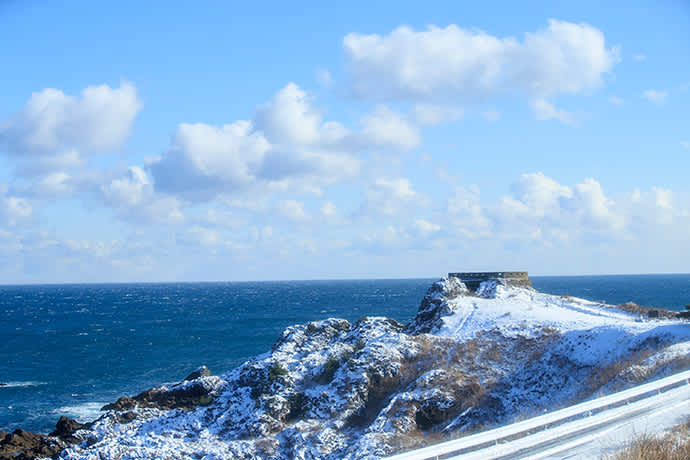
The train makes a temporary stop when the Ashigezaki Observatory comes into view.
As the train runs along the Tanesashi Coast, a salad is served with “instant smoked” swordfish and an apple dressing made from Aomori apples.

The salad is served in a traditional box from Akita called a magewappa, made from cedar and Japanese cypress.
Following the salad is a soup of seri (Japanese parsley), characterized by a slight bitterness and fennel-like aroma, with slices of duck and foie gras. Cooking Japanese parsley in a hot pot is a style specific to Miyagi.
Passengers can enjoy a complimentary drink with their meal, from non-alcohol beverages to beer, cider, and local wines.

Seri (Japanese parsley) is a typical ingredient in Miyagi hot pot. (left) The dishes are prepared in the open kitchen. Watching the dishes being prepared whets the appetite. (right)
The main dish is an innovative creation with multiple layers of flavor. Harako meshi is a local dish from Miyagi Prefecture, combining salmon and salmon roe with seasoned rice. It is served with a creamy soup and slices of chicken breast. The dish is enhanced by the aroma of scattered sorrel leaves and the texture of the salmon roe.

The dish features local ingredients, including rice from Aomori.
As the train slows near the town of Hirono, local residents wave traditional fishing banners (tairyo-bata), to welcome the passengers. Traditionally raised to signal a good catch on return to port, these banners have become a symbol of recovery from the Great East Japan Earthquake, in 2011. It is a heartwarming gesture, showing how much the local communities love this train.

The expansive view from the train window creates a beautiful backdrop for lunch. (left) Local residents wave their banners to welcome the train. (right)
Dessert is a selection of charming petits fours served in a wooden box. Each is a bite-sized sweet from Tohoku, including zunda mochi made with mashed edamame, and Nanbu Senbei crackers.

Pictured from top left are zunda mochi, apple pie, nanbu senbei, and hagi no tsuki—a light sponge cake filled with custard cream, from Sendai (right).
As lunch finishes, the train travels inland towards Kuji and the trip nears its end. The temperature in Tohoku in December is below freezing even during the day, but the people of Kuji put on a warm welcome for the train passengers.

Passengers are welcomed with fishermen’s banners as the train approaches Kuji Station.
The dishes served on Tohoku Emotion are comparable to a top restaurant, and give passengers a tangible experience of Tohoku’s hospitality. The views, the elegant interiors and the relaxing hospitality on the train epitomize the joy of travel.
The lunch course is served on the outbound route from Hachinohe to Kuji. On the return journey, passengers are served a dessert plate. There is also a buffet with a selection of hors d’oeuvres and sweets.
Due to COVID-19, train operation is currently suspended until February 8, 2021 in accordance with the declaration of a state of emergency. Ticket sales are suspended February 9–28. Travel packages for Tohoku Emotion including train tickets and meals can be purchased from March 2021 at travel agencies in Japan, including the JR Travel Service Center, View Plaza.

Desserts served on the Kuji to Hachinohe route. The pictured desserts are designed by pastry chef Takashi Kumagai from Hotel Metropolitan Morioka in Iwate.

The buffet is temporarily suspended due to COVID-19, but the hors d’oeuvres and sweets are available, served to order.
See some of the world’s oldest amber and dine on fresh seafood in Kuji
The Tohoku Emotion arrives at Kuji Station around 1:00 p.m., allowing plenty of time for sightseeing before boarding the Sanriku Railway the next day.
Kuji Amber Museum, about 10 minutes by taxi from the station, is a must-see for visitors to Kuji. The Kuji area is the main amber-producing region in Japan. The amber mined here dates from the Jurassic period to the Cretaceous period, around 85–90 million years ago. Kuji amber is the oldest in the world to be used in jewelry. Visitors to the museum can learn about amber through interactive experiences.

The museum is comprised of two buildings, several workshops, a shop, and a restaurant. There are pamphlets and an audio guide in English and Chinese.
Dioramas help visitors visualize Kuji as it was approximately 90 million years ago, covered by primeval forest. Artworks and exhibits include the world’s largest amber mosaic, and a capsule where visitors can stand to hear a legend about amber, with light and sound. Interactive experiences include producing static electricity using amber and the soothing effect of walking on an amber floor. Amber jewelry is a popular souvenir. Some pieces have beautiful color variations unique to Kuji amber, in addition to the standard rich amber hue.

The “stone of the sun” is a capsule where visitors can hear a legend about the origins of amber, accompanied with light and sound. (left) Kuji amber has a wide array of color variations. (right)
Roadside Station Kuji is about a 15-minute taxi ride from the museum. Roadside stations, or rest areas are convenient facilities for travelers. They are places to park the car and rest, shop for local produce and souvenirs, and enjoy local food. Restaurant Sankairi at the roadside station in Kuji is known for its “amadon”, a dish of rice topped with fresh seafood caught in the Sanriku waters. The dish is named for the ama divers, usually women, who free dive for shellfish in the cold waters Kuji Bay. Amadon features deluxe ingredients such as local abalone, sea urchin, salmon roe, and botan shrimp. The dish comes with sheets of nori seaweed, so diners can make their own hand-rolled sushi.
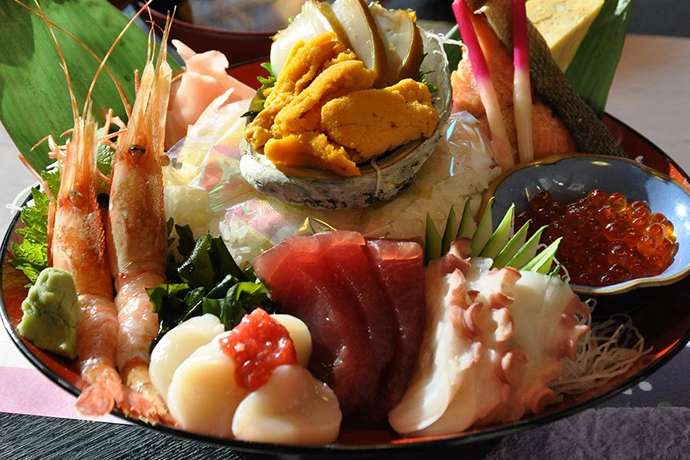
Only five servings of amadon are available a day, but there are other dishes available. Reservations are available.
Take the cozy Kotatsu Train to experience Japanese customs and local cuisine
After a night in one of Kuji’s comfortable hotels, visitors can explore the Kosode Coast. This area is part of Sanriku Fukko National Park, which extends along the coast from southern Aomori Prefecture to the Oshika Peninsula in Miyagi Prefecture. The park was created to contribute to recovery in the Sanriku region, which suffered damage from the Great East Japan Earthquake, in 2011. The cliffs and reefs along the coast have some of the oldest geological formations in Japan. Spectacular rock formations including Tsuriganedo Cave and Kabutoiwa are popular scenic spots.
Kuji is known for its beautiful scenery and popular hiking route Michinoku Coastal Trail, which connects Hachinohe City in Aomori Prefecture to Soma City in Fukushima Prefecture, along the beautiful Pacific Ocean coastline.

Tsuriganedo Cave in Sanriku Fukko National Park is a popular scenic spot.
The Sanriku Railway along the Sanriku Coast sustained heavy damage when the tsunami hit during the Great East Japan Earthquake in 2011, when trains, tracks, and a train station were washed away. However, partial operation resumed five days after the earthquake, giving encouragement to the communities affected by the disaster. The entire line was restored three years later, with donations from around Japan. The two-car local train is a symbol of the area’s regeneration and the resilience of the local people.

The cozy Kuji Station building. The Sanriku Railway is a 163 kilometers (101 miles) line that runs between Kuji and Sakari stations.
The Kotatsu Train is a special, seasonal train on the Sanriku Railway that operates from mid-December to the end of March. A kotatsu is a traditional Japanese heater. It is a low table that has a heater attached to the underside of the table frame. A futon (thick comforter) is placed over the table frame and kept in place by a detachable tabletop, to keep the warmth in. The sight of a family relaxing around the kotatsu is a nostalgic winter scene.
The Kotatsu Train operates throughout the day, with lunch available on the service that departs shortly after noon. The short, two-car train is typical for local railways in rural areas. As part of the measures to prevent the spread of COVID-19, passengers undergo temperature checks and disinfect their hands before boarding. From Kuji Station, the approximately two-hour train journey to Miyako Station begins, stopping at all stations in between.

From April to October, the train operates with tatami mat seating (without the kotatsu heated tables) for events and charter trips. Photo credit: Sanriku Railway Co,.Ltd.
Passengers remove their shoes and step up onto a platform covered with tatami matting, to sit at the kotatsu. There is a footwell under the table, to allow passengers to stretch their legs comfortably.

The interior of the train pre-Covid-19. Currently, acrylic screens are set up to prevent close contact between passengers from different family groups. Photo credit: Sanriku Railway Co,.Ltd.
Passengers that pre-book lunch on the lunch-service Kotatsu Train will find a bento boxed lunch waiting at the table when they board. The area is famous for seafood, and the lunch includes local foods such as steamed sea urchin, Japanese scallops, and tempura served in a boat-shaped dish.

The most extravagant boxed lunch is the seafood meal, served in a boat-shaped dish. On-board sales are limited and pre-booking is recommended. It is also permitted to bring your own food and alcoholic beverages onto the train. Photo credit: Sanriku Railway Co,.Ltd.
The train departs just after noon and journeys through snow-covered forests, to the coast. After passing Nodatamagawa Station and going through three tunnels, the train slows and an announcement alerts passengers that they can see Akkagawa Bridge, a popular viewpoint on the Sanriku Railway.
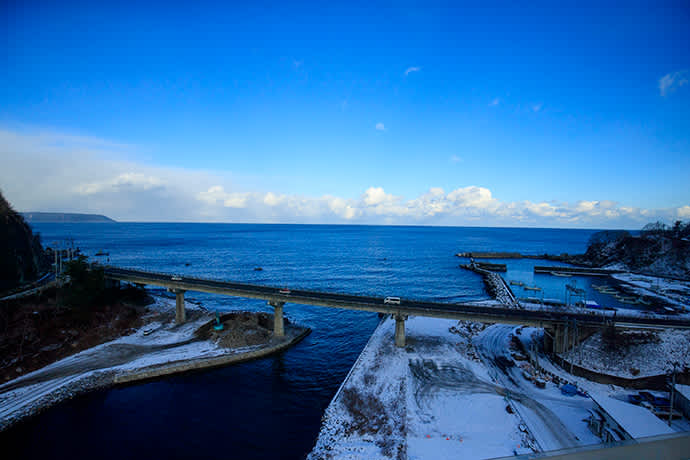
When Akkagawa Bridge comes into view, the announcement is also made in English.
Horinai Station is a stop on the line. It is an unstaffed, retro station with a sweeping view of the Pacific Ocean from the platform.
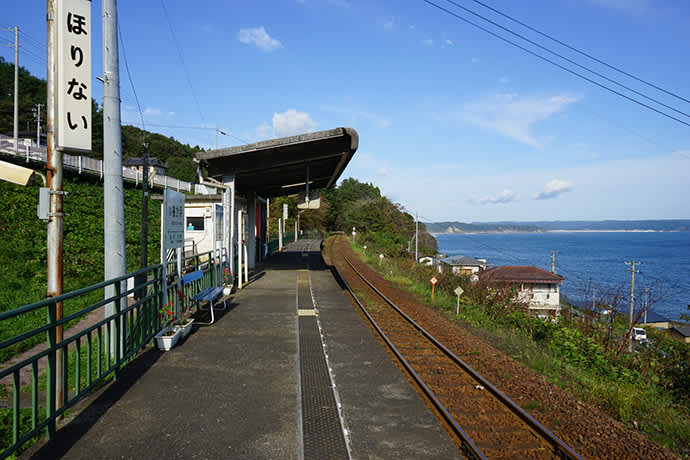
Horinai Station has views of the Pacific Ocean.
Before reaching Shiraikaigan Station, the train stops for about a minute on the Osawa Bridge. The view of the Sanriku Coast from the bridge is a highlight of the trip. The image of a Sanriku Railway train crossing Osawa Bridge with the Pacific Ocean in the background is famous among railway fans.

The view from Osawa Bridge. (left) The Sanriku Railway train crosses Osawa Bridge. (right)
Towards the end of the journey, the lights in the carriages go out and ogres, called namomi, suddenly appear. The namomi, clad in straw costumes, are part of northern Iwate folklore and culture. On January 15, known as koshogatsu or “little New Year”, namomi visit homes to bring health and safety to the families in the coming year.
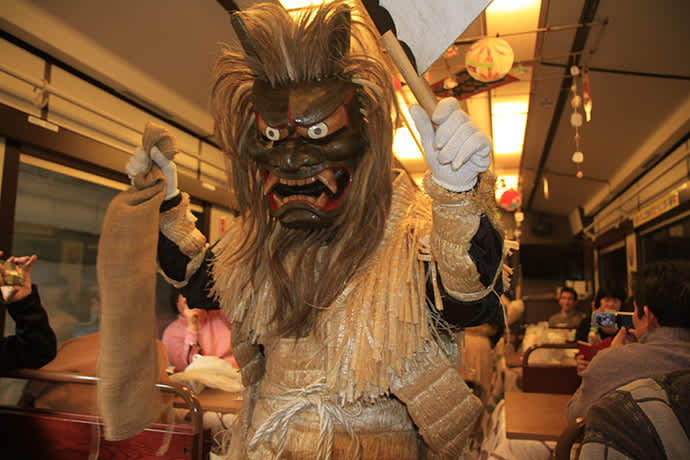
Namomi are considered incarnations of gods. Although they look fearsome, they hand out local sweets to passengers. Photo credit: Sanriku Railway Co,.Ltd.
Shimanokoshi Station is one of the last stops. In 2011, the tsunami washed away the station building, but traces of the past remain, and the station was reconstructed in a red-brick-style.
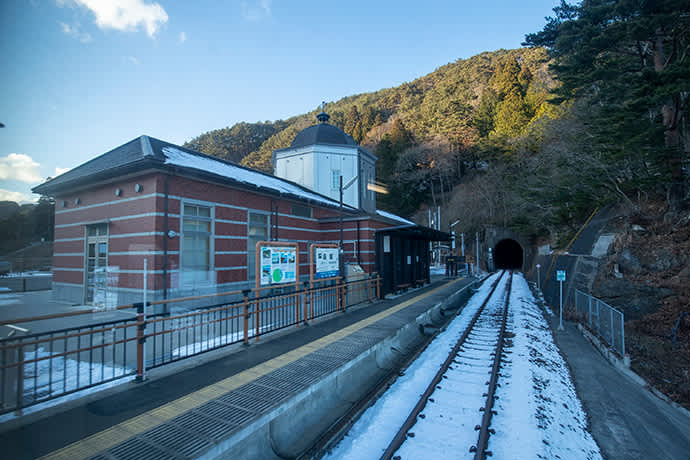
Pictures from before the disaster are on display on the platform at Shimanokoshi Station.
From Shimanokoshi, the train travels inland to the last stop, Miyako Station. As passengers warm themselves in the kotatsu and gaze at the view, it is easy to forget the stresses of daily life.
Traveling on Japan’s nostalgic country railways is an ideal way to see the true face of Japan. On a local train like the Sanriku Railway, visitors can enjoy Japanese culture and customs, along with spectacular views.
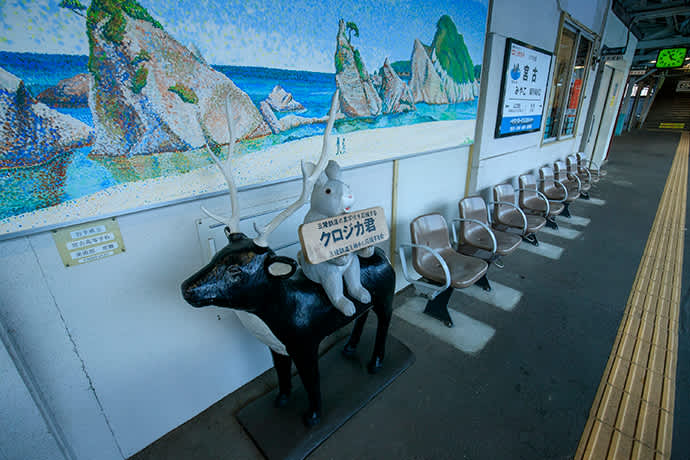
On the platform at Miyako Station platform, visitors can see objects donated by Sanriku Railway fans.
Jodogahama Beach is about 10 minutes by taxi from Miyako Station. The beach, framed by jutting rocks, is believed to have been formed by magma approximately 5,200 years ago. The picturesque spot is part of Sanriku Fukko National Park and a symbol of Iwate. Sightseeing boats take visitors around the inlet, including the popular blue cave.
As part of the measures to prevent the spread of COVID-19, passengers undergo temperature checks and disinfect their hands before boarding the Kotatsu Train. Other measures include wearing masks and thorough disinfection of the train cars by staff.

The clear ocean water and striking rock formations make Jodogahama a popular spot with visitors.
Exploring northern Japan by train
There are many sightseeing trains in northern Japan that allow passengers to experience local attractions and enjoy the countryside. Here are four journeys that make the most of Tohoku’s scenery and culture.
Resort Shirakami
This sightseeing train takes passengers along the western coast of Tohoku from Akita to Aomori, for views along the Sea of Japan. Visitors can use the JAPAN RAIL PASS to travel on the Resort Shirakami, however seats need to be reserved prior to boarding. The train travels through scenic landscapes including the World Heritage Shirakami Mountain Range, and the Senjojiki Coast. The train has an attractive wooden interior with large viewing windows, and hosts occasional events such as live shamisen performances.

The train uses a hybrid diesel system to save energy. (left) The interior design features locally sourced beech and cedar wood. (right) Photo credit: East Japan Railway Company
Kairi
The Kairi offers scenic dining with views of the Sea of Japan as it travels between Niigata and Sakata in Yamagata Prefecture. Visitors can use the JAPAN RAIL PASS to travel on the Kairi, however seats need to be reserved prior to boarding. Passengers can experience local cuisine, prepared by a traditional ryotei restaurant with a history of over 100 years.

The train’s colorful exterior was inspired by the colors of the setting sun and fresh snow. (left) Italian dishes are served on the route from Niigata to Yamagata, and Japanese cuisine is served on the Yamagata to Niigata route. (right) Both photo credit: East Japan Railway Company
Gottsuo Tamatebako Train
Gottsuo means “feast” in the Akita dialect, and this train linking Kakunodate and Aniai in Akita Prefecture serves special homemade boxed lunches of local foods, prepared by people from farms along the line.

The view from the train window changes with seasons. (left) Tasty homemade boxed lunches feature local specialties. (right) Photo credit:Akita Nairiku Jukan Tetsudo Railway Co,.Ltd
Setsugekka
This resort train runs through the Joetsu region of Niigata Prefecture from Itoigawa to Joetsumyoko. Passengers can enjoy a delicious meal prepared by a top local chef, and beautiful scenery of the mountains and sea.

In winter the train runs through a beautiful winter wonderland. (left) The stylish interior is entirely created using materials from Niigata. (right)
Information
JR East reservations (Tohoku Emotion) |
JAPAN RAIL PASS |
Sanriku Railway (Kotatsu Train)Operates on Saturdays, Sundays, and holidays from mid-December to the end of March the following year. |
Kosode Coast |
Jodogahama Beach |
Kuji Amber Museum |
Gottsuo Tamatebako Train (Akita Nairiku Line) |
Setsugekka |
Michinoku Coastal Trail(links to the Ministry of the Environment page) |




















































